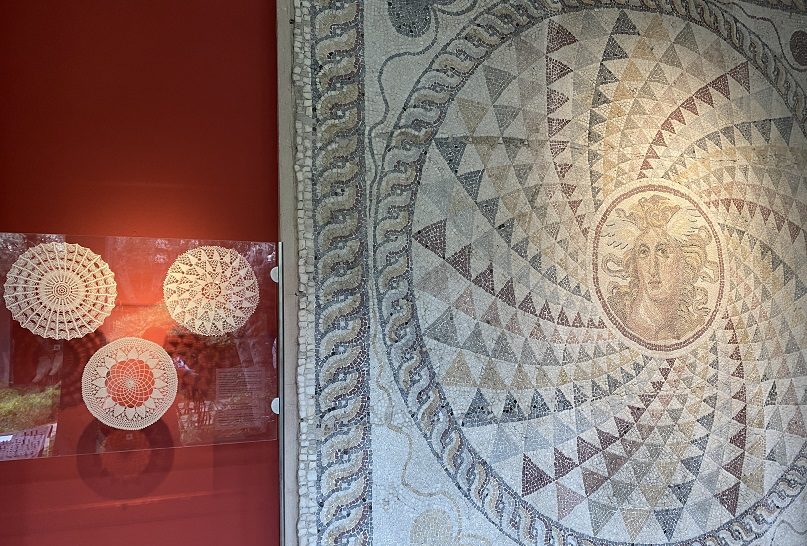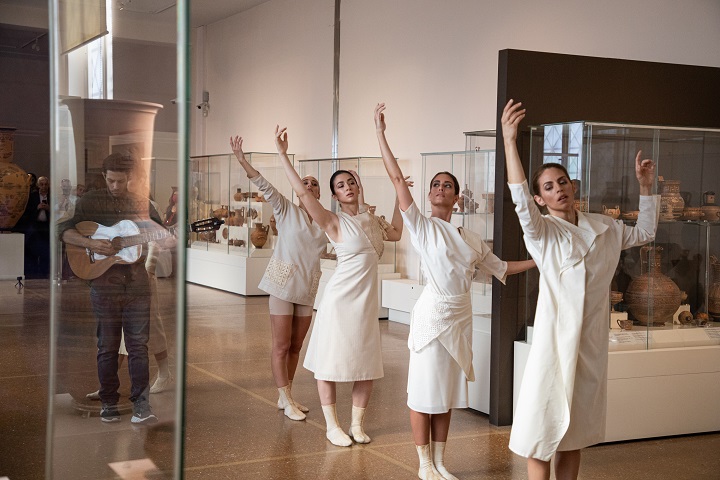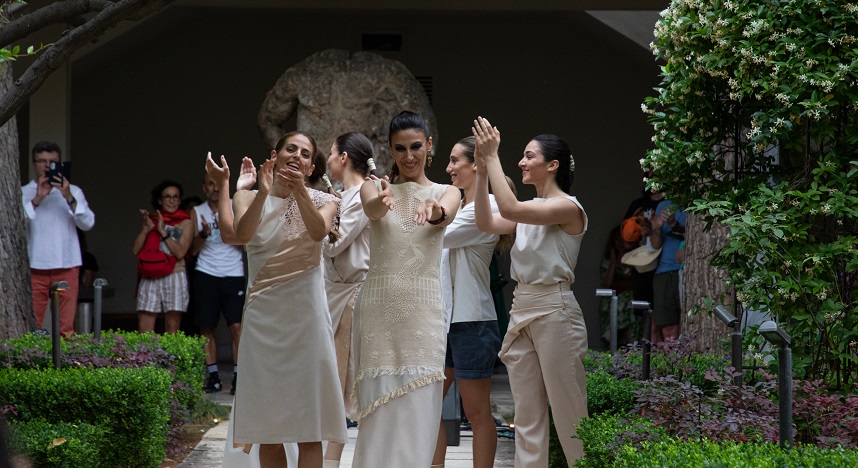
A new exhibition hosted by the National Archaeological Museum in Athens in collaboration with fashion designer Eleni Kyriacou explores the survival of ancient Greek themes and patterns in traditional lacemaking from the 19th and 20th centuries.
The aim is to highlight the significant influence that Greek antiquity has had on Greek lacemaking history – in the clear design influence as well as the influence on subject matter – and to encourage the upcycling and re-appropriation of historic laces into the 21st century.
The exhibition Old Lace, New Life, set around the garden at the lower level of the Museum, is admission-free and will continue until August 31, 2023.
An immersive one-off dance and music performance launched the exhibition on the afternoon of Wednesday, June 7, which took visitors from The Vase Collection on the first floor down to the garden displays, making its way through iconic ancient exhibits.

Historic laces upcycled and re-appropriated
The exhibition idea was started by fashion designer Eleni Kyriacou, who is also known for having designed the current costumes for the priestesses of the Lighting of The Olympic Flame Ceremonies.
Kyriacou salvaged countless historic Greek laces in recent years, resulting in a collection of over a thousand pieces, a selection of which she used to create a womenswear collection proposing an original way of “upcycling fragments of Greek heritage.”
“The laces, by being reclaimed in this manner, are re-contextualised: what was once placed in an architectural context to adorn an interior, rests on the flesh of a woman’s body, thereby transforming the lace in meaning. In this manner 19th and 20th century laces are reappropriated into the 21st century” the Museum notes.
Hence, the collection was launched in conjunction with World Environment Day, to highlight the relation to sustainable art and design.
A riveting dance performance inspired by Greek antiquity
Visitors of the National Archaeological Museum of Athens enjoyed an immersive dance and music performance in its premises on Wednesday afternoon, sponsored by Gallery K – Cypria Auctions.
Sevasti Zafeira, Katerina Mageraki, Iliana Yfanti, Violeta Damanaki and their choreographer, Despina Lagoudaki, danced to the music played by instrumentalists Vasilis Gkoritsas, Elena Leoni, Maria Malafi and Nikos Martziokas, inspired by Greek antiquity and the acoustics made from lacemaking techniques, such as the kopaneli.

Dressed in garments which incorporated salvaged Greek laces in their design, the group performed their way through galleries 49 and 50 of The Vase Collection on the Museum’s first floor, down the marble staircase to the Statues gallery and past the emblematic Jokey of Artemision, before they continued to the garden for the main part of the performance.
Here, salvaged laces from Kyriacou’s collection are juxtaposed with exhibits from Greek antiquity.
A wedding dress designed by Kyriacou with historic laces is also on display.
Besides the physical exhibition taking place in the garden, a virtual exhibition can be viewed online which digitally juxtaposes artefacts from the Museum’s permanent collections with the salvaged laces from Kyriacou’s lace collection, highlighting design influences.

Greek lacemaking as a collective memory
According to archaeologist and social anthropologist Yannoula Kaplani – who is an expert in Greek folk art and helped Kyriacou sort and classify her salvaged laces collection – “one can say that the art of lace exists in contemporary Greek culture as a collective memory.”
“The adoptive and adaptive capabilities of Greek women (where standard designs were taken, then developed and progressed) meant they produced outstanding pieces bearing the hallmark of Greek tradition. They created brilliant works of art, on a par with laces from other prominent European lacemaking centres (such as those of Italy, France, England, Belgium, Denmark, Norway, Czech Republic, Hungary, etc.)” Kaplani adds.

See all the latest news from Greece and the world at Greekreporter.com. Contact our newsroom to report an update or send your story, photos and videos. Follow GR on Google News and subscribe here to our daily email!



